Tibet is a must-go place for all travel lovers. If you want China Tibet tours because you like Tibetan culture, the below Tibet tour package will be the best choice for you. The following Tibet tour package includes all must-see Tibet tourist places. During this tour, you will see the magnificent Potala Palace, the sacred Jokhang Temple, and the bustling Barkhor Street. In addition to these high-profile attractions, you will also visit Yungbulakang Palace and Trandruk Monastery, the earliest palace and monastery in Tibet, to learn the history and traditional culture of Tibet. Let China Tour Star take you out of the travel guidebooks and into the real world of Tibet.

Welcome to Lhasa! When you arrive at the Lhasa airport, you will meet a professional guide who will be waiting for you at the exit with your name sign. And then you will be transferred to a local hotel to have a good rest. The guide will help you with your check-in.
Tibet Autonomous Region (TAR), abbreviated as Tibet, locates southwest of China on the world’s highest plateau with an average altitude of around 4,800 meters. Its administrative capital is Lhasa which has an altitude of 3,650 meters and has more than 3,000 hours of sunshine annually. Therefore, you may suffer from high-altitude reaction syndrome, in particular insomnia, hypoxia, and headache. For your safety, please let your guide know at once if you are uncomfortable. Before every arranged activity, eating as many vegetables and drinking as much water as you can to keep yourself energetic and reduce the discomforts. In addition, you may be burned by strong sunshine without protective equipment such as sunglasses, sunhats, and UPF clothes. For dangerous low temperatures caused by high altitude, warm jackets are also suggested to be taken.
However, Lhasa is more well-known for its beautiful sceneries. Boasting brilliant Buddhist culture and unique plateau landscapes, Lhasa, a time-honored city of over 13 centuries, emerges as a popular destination for modern tourists. So, get ready to explore the wonderland.
Notice:
During the trip, you will visit several famous Buddhist temples and may experience some local festivals, so you should respect the tourist rules and follow what the guide reminds. These include:
1. Photography or any cinematographic activities are prohibited inside the temples.
2. Do not wear hats or step on the thresholds when you are inside the temples.
3. Walk clockwise from left to right when visiting.
4. Do not point at Buddhas.
After having breakfast at the hotel, we will visit the first tourist attraction of the trip: the Potala Palace. The magnificent Potala Palace is Lhasa’s landmark building where government affairs were dealt with and the Dalai Lamas lived in winter. The present scale of the Potala Palace was finished during the reign of the fifth Dalai Lama in 1645 and took more than 50 years to complete. Then, it served as the winter palace of the Dalai Lamas, symbolizing the important position of Tibetan Buddhism in Tibet. The Potala Palace is one of the top ten civil buildings in the world. It is so impressive that it was listed in the World Cultural Heritages along with Jokhang Temple and Norbulingka by UNESCO in 1994.
The palace rises 13 stories from 130m-high Red Hill and contains more than 1,000 rooms. It includes the White Palace used for the living quarters of the Dalai Lamas, and the Red Palace used for religious activities. The jewel-bedecked golden chörtens (Tibetan stupa which is actually tomb pagoda) of several previous Dalai Lamas are housed in halls of the Red Palace. The first recorded use of the Potala Palace was in the 7th century when King Songtsen Gampo (the 33rd leader of the Tubo Kingdom(633-842)) married Princess Wencheng from the Tang Dynasty (618-907). Their marriage greatly contributed to the development of Tibet through cultural and technique exchanges.
After a lunch break, we will go eastward to visit Jokhang Temple firstly. The temple locates at the center of Lhasa City and is also a landmark. It was built in the 7th century and covers an area of 25,100 square meters. As a complex mixing the Tang, Tibetan, and Nepalese styles, the temple is a representative of religious constructions in the Tibetan region. The temple was used to house the statue of Sakyamuni brought by Princess Bhrikuti of Nepal, the first wife of Songtsen Gampo. It was built along a lake. In the legend, every time a monastery was built in the lakeside, it would collapse. Confused by this phenomenon, Princess Bhrikuti turned to Princess Wencheng for help. As an erudite woman, Princess Wencheng thought that Tibet was much like a hag geographically in shape, with the lake at the heart. Only when the lake was filled and the hag was suppressed could a monastery be constructed. Therefore, Princess Wencheng advised using 1,000 goats to carry soil from a mountain far away to fill the lake. The temple was thus originally called Ra-Sa-Vphrul-Snang (‘ra’ means goat and ‘sa’ means earth in the Tibetan language) to commemorate those goats. Later, its name was changed to Jokhang, which means the house of Buddha.
Then we will walk along Barkhor Street, a must-see place for visitors. It is a street surrounding Jokhang Temple in central Lhasa. It is said that after the construction of the magnificent Jokhang Temple, thousands of pilgrims were attracted and came to the temple for worshiping Buddha. Thus, a trodden path appeared. That is the origin of Barkhor Street. Along the street, you will understand the holiness of the religion by walking with pilgrims who hold prayer wheels to walk clockwise along the street from dawn to darkness. Nowadays, the street is not only a place for religious followers, but also for all. It has developed into a thriving bazaar. Shops stand on both sides and numerous stands are on every corner. Prayer wheels, long-sleeve ‘chuba’ (the Tibetan people's traditional clothes), Tibetan knives, and ‘Thangka’ (the Tibetan scroll painting) are offered in these shops and stands. Surprisingly, commodities from neighboring countries, such as Nepal and Burma, are also sold here.

After having breakfast, we will visit Norbulingka, a summer palace and the biggest man-made garden in Tibet. “Norbulingka” means “Treasure Park” in the Tibetan language. It was built in the 1840s and assumed today’s scale after more than 200 years’ expansion. Today, the whole garden consists of three parts, covering an area of 360,000 square meters with 374 rooms. There are more than 100 kinds of plants, including local flowers and trees and exotic ones from the vicinity of the Himalayas. Besides elegant buildings and diverse plants, Norbulingka is famous for Sho Dun Festival (a traditional religious festival for all the Tibetans held annually). In Tibetan, “Sho” refers to yogurt, and “Ton” refers to a banquet. Therefore, it is a feast of eating yogurt. The festival spans from late June or early July of the Tibetan calendar, which usually falls in August of the solar calendar. People will have a picnic, watch the traditional Tibetan Opera, and chant the religious scriptures in Norbulingka. If you encounter this festival when you visit Tibet, you will experience the most authentic Tibetan culture.
Then we will drive about 20 minutes westward to Drepung Monastery. It is on the Gambo Utse Mountain and has a magnificent complex of white buildings. From a distance, it is much like a huge rice pile. That is why the temple was named “Drepung” which means “gathering rice” in Tibetan. The monastery was founded by Jamyang Chojey, the founder of the Gelug Sect of Tibetan Buddhism, in 1416. It is the biggest one of all the Tibetan monasteries and holds 7,700 monks in its heyday. It is so large that most visitors choose to visit the most important buildings such as the Main Assembly Hall and the Ganden Palace. The Main Assembly Hall is a three-story building where a three-floor high Future Buddha is enshrined, and the Ganden Palace was a regional political power center of Tibet before the fifth Dalai Lama moved to the Potala Palace every winter. In addition, Drepung Monastery is known for the high standards of its academic study. In the late 1930s, Drepung developed into an important educational center with four colleges, each housing monks from a different locality. Throughout its history, many Dalai Lamas used to study here. For this reason, the monastery is acclaimed as the “Mother Monastery of the Dalai Lamas”. In addition, it is also an important place to celebrate Sho Dun Festival.
We will have lunch at a local restaurant. After that, we will visit Sera Monastery. It is at the foot of Tatipu Hill. “Sera” means “rose” in Tibetan. It is said that the hill behind the temple was covered with wild roses when the temple was built. Historical records show that its construction started in 1419 and finished in 1434, a span during the Ming Dynasty (1368-1644). It includes the Coqen Hall, Zhacangs (colleges), and Kamcun (dormitory). The complex houses many precious cultural relics, arts, and scriptures. Among them, the proudest possession is the Beijing edition of Ganggyur written in gold powder ink (Ganggyur is the principal collection of the Buddhist scriptures) in 1413 enshrined in the Coqen Hall. The silk Thangka painting made with colorful silk thread in complicated embroidery techniques is also a precious relic preserved here.
When you finish your visit to Sera Monastery, our guide and driver will bring you back to the hotel. You are always reminded to get to bed early to be energetic in case that you suffer from high-altitude reaction syndrome.
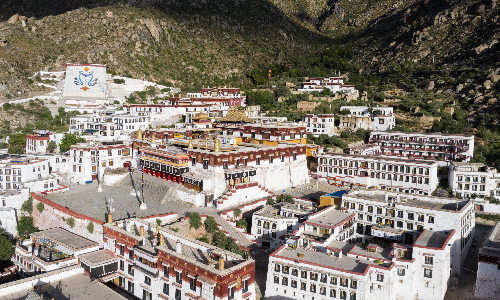
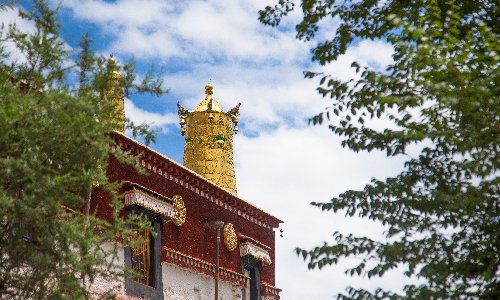
 Tsetang
Tsetang Breakfast will be served at the hotel, and after that, we will go to Tsetang, an ancient town with an average altitude of 3,600 meters. Tsetang is 150 kilometers southeast of Lhasa and it will take us about 2 hours to drive there.
After arrival, we will visit Yungbulakang Palace first. The palace is reputed to be the first palace in Tibet history. It is said that Yungbulakang Palace was built in the second century BC by the first Tibetan king, Nyatri Tsenpo, who descended from heaven. As a legend tells, a divined scripture descended at the top of the palace. However, no one could understand the contents of the scripture so that it was preserved at the palace. Until hundred years later, someone recognized that book was about Buddhism. For this reason, Yungbulakang Palace is also reputed as a holy palace of Buddhism. The palace consists of two parts: a multi-story building built by Songtsen Gampo, and a square fort-styled watchtower by Nyatri Tsenpo. The multi-story building serves as a Buddha Hall where the statue of Sakyamuni is enshrined. With the great efforts of maintenance and reconstruction, the time-honored building has been well preserved.
The guide will take you to a restaurant nearby to have lunch, and then you will continue the trip southwest for the second spot: Trandruk Monastery. It is famous throughout Tibet since it was the first Buddhist temple in Tibet and it is a representative temple of the Gelug Sect. According to the local legend, the site of Trandruk Monastery once was a large lake. People around the lake lived in torment and fear because there was an evil dragon in the lake. To defeat the dragon and bring the locals back to peace, Songtsen Gampo turned into a roc and fought with the dragon. Eventually, the dragon was killed. To commemorate Songtsen Gampo’s great deeds, Trandruk Monastery was thus built. In Tibetan, “Trandruk” means a roc and a dragon. Trandruk Monastery is also famous for Tibetan Thangka that it houses. The most valuable one is named Pearl Thangka. The precious Thangka is a special art of Tibetan Buddhism and is a depiction of Buddha’s various teachings. The Pearl Thangka is made up of about 30,000 pearls and hundreds of other gems like diamonds, sapphires, turquoise, rubies, and ambers. Besides Pearl Thangka, a bronze bell hanging in the inner gallery is also a very important treasure here. This bronze bell, with Tibetan inscriptions, was made by a monk of Han nationality. It is a historical witness of the close cultural and religious exchanges between the Tang Dynasty and Tibet. Throughout the history of Tibet, Trandruk Monastery made great contributions to Tibetan Buddhism and the local culture.
After visiting the two famous sites, you will overnight at a local hotel in Tsetang.
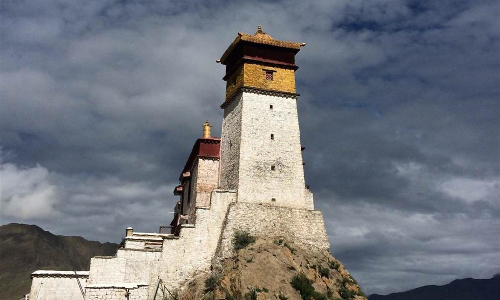

 Lhasa
Lhasa After breakfast at the hotel, we will drive for about 40 minutes to the destination of today’s trip: Samye Monastery. Built in the 8th century, Samye Monastery is the first official temple in Tibet. Samye is famed not only for its long history but also for its unique design: the Main Hall represents the center of the universe, while the outer temples represent the oceans, continents, subcontinents, and other parts of the Buddhist cosmology. The monastery distinguishes itself by integrating Tibetan, Han, and Indian styles.
If you are lucky enough to encounter the local festival, you can immerse yourself in the local culture by taking part in some special activities. Among them, the most interesting one is Universal Pray Day. The festival is held in May of the Tibetan calendar, usually in July of the solar calendar. It is a festival to celebrate Guru Rinpoche’s subjugation of the local deities (Guru Rinpoche, also known as Padmasambhava, is the founder of Tibetan Buddhism and Samye Monastery). During the festival, Tibetans are dressed in beautiful national costumes and go into the woods with highland barley wine, butter tea, and various delicious food. They enjoy the happiness of eating, drinking, singing, and dancing. Moreover, they are so friendly that they always invite others to join in.
Lunch will be in a Tibetan restaurant, and then we will drive you back to Lhasa. The guide will book a local hotel in advance, and help you with your check-in. There is no more arranged tour today, so you can explore the city as you wish or just have a good rest.
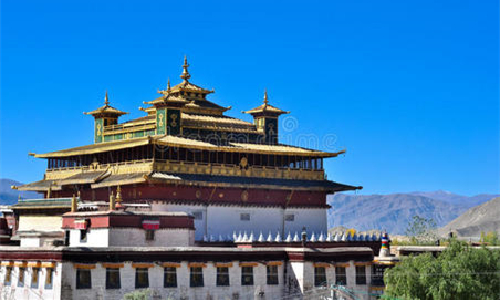
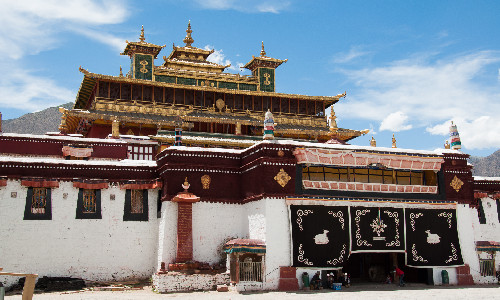
After breakfast, the guide will send you to Lhasa Gongga International Airport according to your flight time. Wish you a pleasant journey!
Editor: Hu Guoyu
Proofreader: Summer Hou
| City | Five Star hotel list | Four Star hotel list |
|---|---|---|
| Lhasa | Shangri-La Hotel, Lhasa | Thangka hotel |
| Tsetang | Guest House | Guest House |
 |
![]() About your child or infant, please contact us for a discounted price.
About your child or infant, please contact us for a discounted price.



We started with a few days in Beijing & ended in Shanghai, from where we visited the Forbidden City and Great Wall. In between we visited Terra Cotta Warriors Museum, Panda Base, Shanghai Disneyland.

We had a wonderful holiday in China which will remain long in the memory. China is a breathtakingly beautiful country full of splendid temples and palaces, mountains and rivers, peaceful rural scenes and bustling shopping streets.
 QUICK ENQUIRY
QUICK ENQUIRY